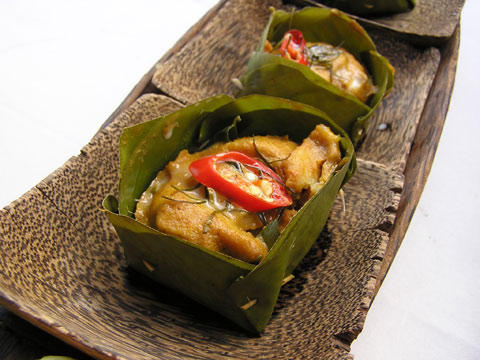អាមុកត្រីរ៉ស
If there is one item of Cambodian food that incites real passion amongst tourists to Cambodia, it is fish amok (amok trei). The mousseline fish curry steamed in a banana leaf container is one of the few Cambodian foods that consistently strikes a chord with foreigners from everywhere. As much as I try to hook my visiting compatriots on sour soups and fermented fish, nothing paves the way into Khmer cuisine as smoothly as a good amok.
I know that I’ll be pistol-whipped by a motivated official from the Ministry of Tourism for pointing this out but fish amok isn’t uniquely Cambodian. Most people in the South East Asian region caught onto cooking coconut and fish mousse in a banana leaf at some point in history. Although its origin was possibly in the Khmer empire, Thailand does a practically identical version of it named “hor mok“. Peranakan cuisine also has”otak-otak” which generally uses fish paste instead of fish chunks. I’ve heard rumour that there is a similar variety of “pepes ikan” in Indonesia (distinct from the Indonesian Peranakan edition) but have not been able to find any corroborating evidence thus far.
In the Khmer language, amok only refers to the dish, whereas in Thai “hor mok” translates as something like “bury wrap” suggesting that on a linguistic basis, amok probably came from Cambodia’s immediate neighbours. A much less likely linguistic explanation for amok’s cloudy origins is to follow the trail of the word amok, whose genesis is from the 17th century Portuguese word amouco. Amouco entered into the Portuguese vernacular through their colonisation of Malaysia and is originally from the Malay amok (“rushing in a frenzy”). Could the early Portuguese settlers or Malay traders in Cambodia carried the recipe for Peranakan otak otak with them from Malaysia resulting in the more frenzied Khmer version? It is unlikely but not outside the realm of possibility as Portugal’s culinary influence in the region resulted in starting the pan-Asian chilli addiction.
The problem with writing Cambodian food histories is that is impossible to trace recipes beyond two generations for almost all Cambodian foods. Recipes in Cambodian cuisine are orally transmitted and when a generation forgets a recipe then it disappears. Generations also modify recipes to their tastes or simply due to the dictates of the seasons or their fortunes. In this context, claiming a food is historically authentic or not is ludicrous – it might be what their grandmother cooked but beyond that lays pure conjecture. While some believe that the Khmer Rouge era destroyed much of Cambodian cuisine, I tend to take the contrary view that due to recipes being so widely distributed in society combined with the unimaginable resilience of Cambodia’s people meant that only the most marginal foods disappeared.






No comments:
Post a Comment